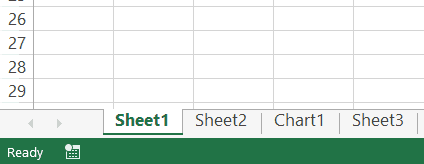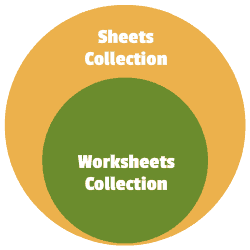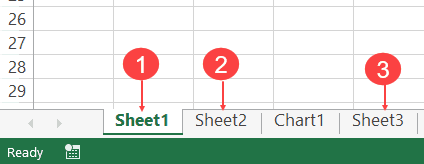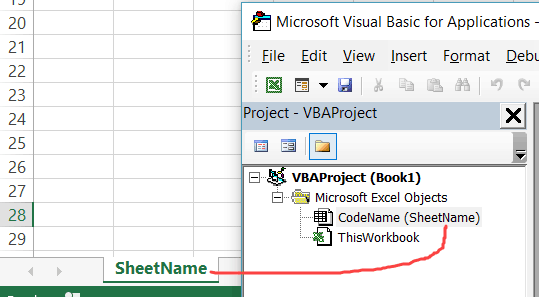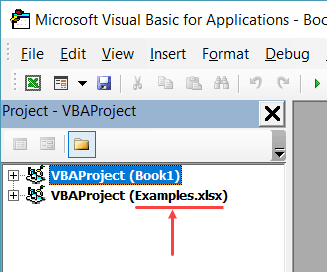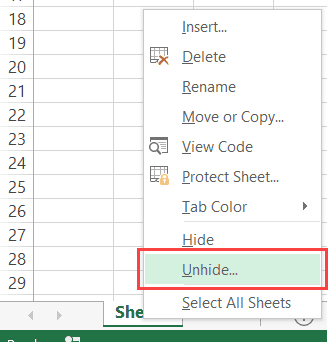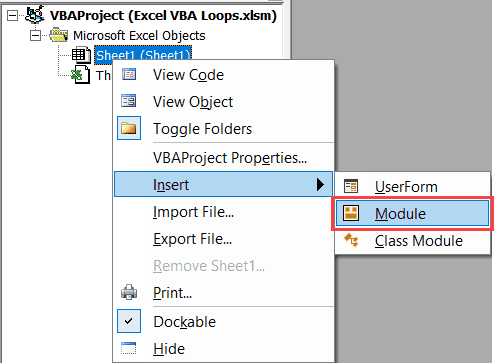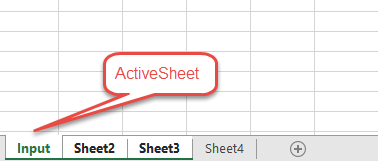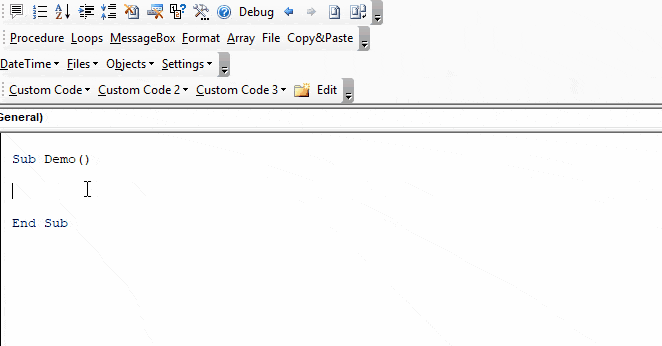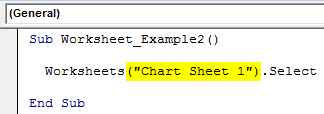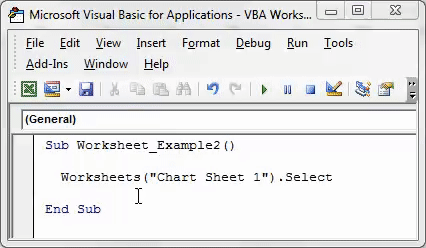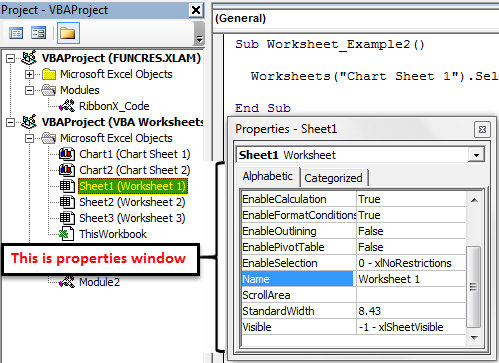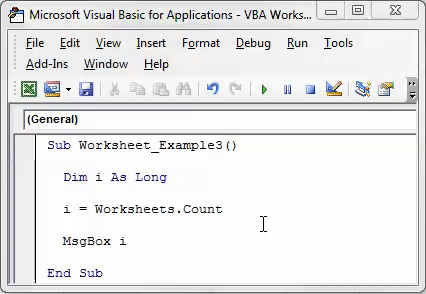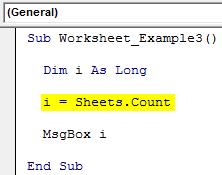Home / VBA / VBA Objects / VBA Worksheet Object -Working with Excel Worksheet in VBA
In VBA, the worksheet object represents a single worksheet that is a part of the workbook’s worksheets (or sheets) collection. Using the worksheet object, you can refer to the worksheet in a VBA code, and refer to a worksheet you can also get access to the properties, methods, and events related to it.
Here’s a small snapshot of where a worksheet stands in the Excel object hierarchy.
Application ➪ Workbook ➪ Worksheets ➪ Worksheet
In this tutorial, we will learn about using and referring to a worksheet in Excel using a VBA code.
Helpful Links: Run a Macro – Macro Recorder – Visual Basic Editor – Personal Macro Workbook
Sheets Vs. Worksheets
First thing first. This is important to understand the difference between a worksheet and a sheet. In Excel, you have types of sheets that you can insert into a workbook, and a worksheet is one of those types. As you can see in the below snapshot when you insert a new sheet Excel asks you to select the sheet type.
Here’s the point to understand: When you use the word “Sheets” you are referring to all the sheets (Worksheets, Macro Sheets, and Chart Sheets), but when you use the word “Worksheet” you are referring only to the worksheets (see also).

Accessing a Worksheet (Sheet) using VBA
VBA gives you different ways to access a worksheet from a workbook, and ahead, we will see different ways to do that.
1. Refer to a Sheet using the Name
Every sheet has its name to identify it, and you can use it to refer to that sheet as well. Let’s say you want to refer to the “Sheet1”, the code would be:

Sheets(“Sheet1”)
Worksheets(“Sheet1”)Both above codes refer to the “Sheet1”.
2. Refer to Sheet using Number
You can also use a sheet’s number to refer to it. Let’s if a sheet is at the fifth position in the workbook then you can use this number to refer to it.
Sheets (5)
Worksheets (5)Now here above two lines of code work in two different ways. The first line refers to the 5th sheet, and the second line refers to the 5th worksheet in the workbook.

3. Refer to the ActiveSheet
If a sheet is already active, then you can refer to it, using the keyword “Activesheet” instead of its name.
ActiveSheetIf you want to perform an activity in the ActiveSheet, you can use the “Activesheet” object, but if you skip using it, VBA will still perform the activity in the active sheet.
Read: Select a Range using VBA
4. Refer to a Sheet using Code Window Name
Each sheet has its code window, and there’s a name to that code window. Usually, a user can change the sheet name from the tab, but the name that you have in the code window can’t be changed unless you do it from the properties.
Open the Visual Basic Editor from the Developer Tab, and in the properties section, you can see the name of the sheet that you have selected.

And you can also change this name from the properties section.

Now you can refer to it by using the code window name.
mySheet5. Refer to More than One Sheet
You can also refer to more than one sheet in one go using a single line of code. For this, you can use an array, just like the following code.
Sheets(Array("Sheet1", "Sheet2"))This code refers to “Sheet1” and “Sheet2”, but, there’s one thing that you need to understand when you refer to more than one sheet, there are a few methods and properties that you can’t use.
6. Refer to Sheet in a Different Workbook
A worksheet or a sheet is a part of the worksheets collection in a workbook, and if you want to refer to a specific sheet other than the active workbook, then you need to refer to that workbook first.
Workbooks("Book1").Sheets("Sheet1")To run this code, you need to have “Book1” open.
Properties, Methods, and Events Related to a Sheet or a Worksheet
In VBA, each Excel object has some properties, methods, and events that you can use, and in the same way, you can access the properties and methods that come with it. Once you specify a worksheet, type a dot (.), and you’ll get the list.

In this list, all the icons where you can see a hand are properties, and where you have green brick are methods.
Property Example
Let’s say you want to change the color of the worksheet’s tab, in this case, you can use the TAB property of the worksheet.
mySheet.Tab.ThemeColor = xlThemeColorAccent2In the above line of code, you have the tab property and further theme color property to change the tab color of the worksheet.
Method Example
In the same way, you can use the methods that come with worksheets. One of the most common methods is the “Select” method that you can use to select a sheet.
mySheet.SelectThe moment you run this code, it selects the “mySheet” from the active workbook.
Event Example
Some events are associated with a worksheet. For example, when you activate a sheet, that’s an event, and in the same way, when you change something within the sheet. See the following code where you have code to run when an event (change in the worksheet) happens.

Private Sub Worksheet_SelectionChange(ByVal Target As Range)
Range("A1").Value = Range("A1").Value + 1
End SubThis code enters a value in the cell A1 of the sheet every time you make a change in the worksheet.
Declaring a Worksheet Object
You can also declare a variable as a worksheet, making it easy to use that worksheet in a VBA code. First, use the DIM keyword, and then the name of the variable. After that, specify the object type as a worksheet.

More on VBA Worksheets
Activate a Sheet | Add a New Sheet | Copy a Sheet | Rename a Sheet | Hide a Sheet | Delete Sheet | Protect Sheet | Clear a Sheet | Check IF Sheet Exists | Loop Through Each Sheet in the Workbook | Count Sheets
- VBA Tutorial
Apart from cells and ranges, working with worksheets is another area you should know about to use VBA efficiently in Excel.
Just like any object in VBA, worksheets have different properties and methods associated with it that you can use while automating your work with VBA in Excel.
In this tutorial, I will cover ‘Worksheets’ in detail and also show you some practical examples.
So let’s get started.
All the codes I mention in this tutorial need to be placed in the VB Editor. Go to the ‘Where to Put the VBA Code‘ section to know how it works.
If you’re interested in learning VBA the easy way, check out my Online Excel VBA Training.
Difference between Worksheets and Sheets in VBA
In VBA, you have two collections that can be a bit confusing at times.
In a workbook, you can have worksheets and as well as chart sheets. The example below has three worksheets and one chart sheet.
In Excel VBA:
- The ‘Worksheets’ collection would refer to the collection of all the worksheet objects in a workbook. In the above example, the Worksheets collection would consist of three worksheets.
- The ‘Sheets’ collection would refer to all the worksheets as well as chart sheets in the workbook. In the above example, it would have four elements – 3 Worksheets + 1 Chart sheet.
If you have a workbook that only has worksheets and no chart sheets, then ‘Worksheets’ and ‘Sheets’ collection is the same.
But when you have one or more chart sheets, the ‘Sheets’ collection would be bigger than the ‘Worksheets’ collection
Sheets = Worksheets + Chart Sheets
Now with this distinction, I recommend being as specific as possible when writing a VBA code.
So if you have to refer to worksheets only, use the ‘Worksheets’ collection, and if you have to refer to all sheets (including chart sheets), the use the ‘Sheets’ collection.
In this tutorial, I will be using the ‘Worksheets’ collection only.
Referencing a Worksheet in VBA
There are many different ways you can use to refer to a worksheet in VBA.
Understanding how to refer to worksheets would help you write better code, especially when you’re using loops in your VBA code.
Using the Worksheet Name
The easiest way to refer to a worksheet is to use its name.
For example, suppose you have a workbook with three worksheets – Sheet 1, Sheet 2, Sheet 3.
And you want to activate Sheet 2.
You can do that using the following code:
Sub ActivateSheet()
Worksheets("Sheet2").Activate
End Sub
The above code asks VBA to refer to Sheet2 in the Worksheets collection and activate it.
Since we are using the exact sheet name, you can also use the Sheets collection here. So the below code would also do that same thing.
Sub ActivateSheet()
Sheets("Sheet2").Activate
End Sub
Using the Index Number
While using the sheet name is an easy way to refer to a worksheet, sometimes, you may not know the exact name of the worksheet.
For example, if you’re using a VBA code to add a new worksheet to the workbook, and you don’t know how many worksheets are already there, you would not know the name of the new worksheet.
In this case, you can use the index number of the worksheets.
Suppose you have the following sheets in a workbook:
The below code would activate Sheet2:
Sub ActivateSheet() Worksheets(2).Activate End Sub
Note that we have used index number 2 in Worksheets(2). This would refer to the second object in the collection of the worksheets.
Now, what happens when you use 3 as the index number?
It will select Sheet3.
If you’re wondering why it selected Sheet3, as it’s clearly the fourth object.
This happens because a chart sheet is not a part of the worksheets collection.
So when we use the index numbers in the Worksheets collection, it will only refer to the worksheets in the workbook (and ignore the chart sheets).
On the contrary, if you’re using Sheets, Sheets(1) would refer to Sheets1, Sheets(2) would refer to Sheet2, Sheets(3) would refer to Chart1 and Sheets(4) would refer to Sheet3.
This technique of using index number is useful when you want to loop through all the worksheets in a workbook. You can count the number of worksheets and then loop through these using this count (we will see how to do this later in this tutorial).
Note: The index number goes from left to right. So if you shift Sheet2 to the left of Sheet1, then Worksheets(1) would refer to Sheet2.
Using the Worksheet Code Name
One of the drawbacks of using the sheet name (as we saw in the section above) is that a user can change it.
And if the sheet name has been changed, your code wouldn’t work until you change the name of the worksheet in the VBA code as well.
To tackle this problem, you can use the code name of the worksheet (instead of the regular name that we have been using so far). A code name can be assigned in the VB Editor and doesn’t change when you change the name of the sheet from the worksheet area.
To give your worksheet a code name, follow the below steps:
- Click the Developer tab.
- Click the Visual Basic button. This will open the VB Editor.
- Click the View option in the menu and click on Project Window. This will make the Properties pane visible. If the Properties pane is already visible, skip this step.
- Click on the sheet name in the project explorer that you want to rename.
- In the Properties pane, change the name in the field in front of (Name). Note that you can’t have spaces in the name.
The above steps would change the name of your Worksheet in the VBA backend. In the Excel worksheet view, you can name the worksheet whatever you want, but in the backend, it will respond to both the names – the sheet name and the code name.
In the above image, the sheet name is ‘SheetName’ and the code name is ‘CodeName’. Even if you change the sheet name on the worksheet, the code name still remains the same.
Now, you can use either the Worksheets collection to refer to the worksheet or use the codename.
For example, both the line will activate the worksheet.
Worksheets("Sheetname").Activate
CodeName.Activate
The difference in these two is that if you change the name of the worksheet, the first one wouldn’t work. But the second line would continue to work even with the changed name. The second line (using the CodeName) is also shorter and easier to use.
Referring to a Worksheet in a Different Workbook
If you want to refer to a worksheet in a different workbook, that workbook needs to be open while the code runs, and you need to specify the name of the workbook and the worksheet that you want to refer to.
For example, if you have a workbook with the name Examples and you want to activate Sheet1 in the Example workbook, you need to use the below code:
Sub SheetActivate()
Workbooks("Examples.xlsx").Worksheets("Sheet1").Activate
End Sub
Note that if the workbook has been saved, you need to use the file name along with the extension. If you’re not sure what name to use, take help from Project Explorer.
In case the workbook has not been saved, you don’t need to use the file extension.
Adding a Worksheet
The below code would add a worksheet (as the first worksheet – i.e., as the leftmost sheet in the sheet tab).
Sub AddSheet() Worksheets.Add End Sub
It takes the default name Sheet2 (or any other number based on how many sheets are already there).
If you want a worksheet to be added before a specific worksheet (say Sheet2), then you can use the below code.
Sub AddSheet()
Worksheets.Add Before:=Worksheets("Sheet2")
End Sub
The above code tells VBA to add a sheet and then uses the ‘Before’ statement to specify the worksheet before which the new worksheet should to be inserted.
Similarly, you can also add a sheet after a worksheet (say Sheet2), using the below code:
Sub AddSheet()
Worksheets.Add After:=Worksheets("Sheet2")
End Sub
If you want the new sheet to be added to the end of the sheets, you need to first know how many sheets are there. The following code first counts the number of sheets, and the adds the new sheet after the last sheet (to which we refer using the index number).
Sub AddSheet() Dim SheetCount As Integer SheetCount = Worksheets.Count Worksheets.Add After:=Worksheets(SheetCount) End Sub
Deleting a Worksheet
The below code would delete the active sheet from the workbook.
Sub DeleteSheet() ActiveSheet.Delete End Sub
The above code would show a warning prompt before deleting the worksheet.
If you don’t want to see the warning prompt, use the below code:
Sub DeleteSheet() Application.DisplayAlerts = False ActiveSheet.Delete Application.DisplayAlerts = True End Sub
When Application.DisplayAlerts is set to False, it will not show you the warning prompt. If you use it, remember to set it back to True at the end of the code.
Remember that you can’t undo this delete, so use the above code when you’re absolutely sure.
If you want to delete a specific sheet, you can do that using the following code:
Sub DeleteSheet()
Worksheets("Sheet2").Delete
End Sub
You can also use the code name of the sheet to delete it.
Sub DeleteSheet() Sheet5.Delete End Sub
Renaming the Worksheets
You can modify the name property of the Worksheet to change its name.
The following code will change the name of Sheet1 to ‘Summary’.
Sub RenameSheet()
Worksheets("Sheet1").Name = "Summary"
End Sub
You can combine this with the adding sheet method to have a set of sheets with specific names.
For example, if you want to insert four sheets with the name 2018 Q1, 2018 Q2, 2018 Q3, and 2018 Q4, you can use the below code.
Sub RenameSheet() Dim Countsheets As Integer Countsheets = Worksheets.Count For i = 1 To 4 Worksheets.Add after:=Worksheets(Countsheets + i - 1) Worksheets(Countsheets + i).Name = "2018 Q" & i Next i End Sub
In the above code, we first count the number of sheets and then use a For Next loop to insert new sheets at the end. As the sheet is added, the code also renames it.
Assigning Worksheet Object to a Variable
When working with worksheets, you can assign a worksheet to an object variable, and then use the variable instead of the worksheet references.
For example, if you want to add a year prefix to all the worksheets, instead of counting the sheets and the running the loop that many numbers of times, you can use the object variable.
Here is the code that will add 2018 as a prefix to all the worksheet’s names.
Sub RenameSheet() Dim Ws As Worksheet For Each Ws In Worksheets Ws.Name = "2018 - " & Ws.Name Next Ws End Sub
The above code declares a variable Ws as the worksheet type (using the line ‘Dim Ws As Worksheet’).
Now, we don’t need to count the number of sheets to loop through these. Instead, we can use ‘For each Ws in Worksheets’ loop. This will allow us to go through all the sheets in the worksheets collection. It doesn’t matter whether there are 2 sheets or 20 sheets.
While the above code allows us to loop through all the sheets, you can also assign a specific sheet to a variable.
In the below code, we assign the variable Ws to Sheet2 and use it to access all of Sheet2’s properties.
Sub RenameSheet()
Dim Ws As Worksheet
Set Ws = Worksheets("Sheet2")
Ws.Name = "Summary"
Ws.Protect
End Sub
Once you set a worksheet reference to an object variable (using the SET statement), that object can be used instead of the worksheet reference. This can be helpful when you have a long complicated code and you want to change the reference. Instead of making the change everywhere, you can simply make the change in the SET statement.
Note that the code declares the Ws object as the Worksheet type variable (using the line Dim Ws as Worksheet).
Hide Worksheets Using VBA (Hidden + Very Hidden)
Hiding and Unhiding worksheets in Excel is a straightforward task.
You can hide a worksheet and the user would not see it when he/she opens the workbook. However, they can easily unhide the worksheet by right-clicking on any sheet tab.
But what if you don’t want them to be able to unhide the worksheet(s).
You can do this using VBA.
The code below would hide all the worksheets in the workbook (except the active sheet), such that you can not unhide it by right-clicking on the sheet name.
Sub HideAllExcetActiveSheet() Dim Ws As Worksheet For Each Ws In ThisWorkbook.Worksheets If Ws.Name <> ActiveSheet.Name Then Ws.Visible = xlSheetVeryHidden Next Ws End Sub
In the above code, the Ws.Visible property is changed to xlSheetVeryHidden.
- When the Visible property is set to xlSheetVisible, the sheet is visible in the worksheet area (as worksheet tabs).
- When the Visible property is set to xlSheetHidden, the sheet is hidden but the user can unhide it by right-clicking on any sheet tab.
- When the Visible property is set to xlSheetVeryHidden, the sheet is hidden and cannot be unhidden from worksheet area. You need to use a VBA code or the properties window to unhide it.
If you want to simply hide sheets, that can be unhidden easily, use the below code:
Sub HideAllExceptActiveSheet() Dim Ws As Worksheet For Each Ws In ThisWorkbook.Worksheets If Ws.Name <> ActiveSheet.Name Then Ws.Visible = xlSheetHidden Next Ws End Sub
The below code would unhide all the worksheets (both hidden and very hidden).
Sub UnhideAllWoksheets() Dim Ws As Worksheet For Each Ws In ThisWorkbook.Worksheets Ws.Visible = xlSheetVisible Next Ws End Sub
Related Article: Unhide All Sheets In Excel (at one go)
Hide Sheets Based on the Text in it
Suppose you have multiple sheets with the name of different departments or years and you want to hide all the sheets except the ones that have the year 2018 in it.
You can do this using a VBA INSTR function.
The below code would hide all the sheets except the ones with the text 2018 in it.
Sub HideWithMatchingText() Dim Ws As Worksheet For Each Ws In Worksheets If InStr(1, Ws.Name, "2018", vbBinaryCompare) = 0 Then Ws.Visible = xlSheetHidden End If Next Ws End Sub
In the above code, the INSTR function returns the position of the character where it finds the matching string. If it doesn’t find the matching string, it returns 0.
The above code checks whether the name has the text 2018 in it. If it does, nothing happens, else the worksheet is hidden.
You can take this a step further by having the text in a cell and using that cell in the code. This will allow you to have a value in the cell and then when you run the macro, all the sheets, except the one with the matching text in it, would remain visible (along with the sheets where you’re entering the value in the cell).
Sorting the Worksheets in an Alphabetical Order
Using VBA, you can quickly sort the worksheets based on their names.
For example, if you have a workbook that has sheets for different department or years, then you can use the below code to quickly sort these sheets in an ascending order.
Sub SortSheetsTabName() Application.ScreenUpdating = False Dim ShCount As Integer, i As Integer, j As Integer ShCount = Sheets.Count For i = 1 To ShCount - 1 For j = i + 1 To ShCount If Sheets(j).Name < Sheets(i).Name Then Sheets(j).Move before:=Sheets(i) End If Next j Next i Application.ScreenUpdating = True End Sub
Note that this code works well with text names and in most of the cases with years and numbers too. But it can give you the wrong results in case you have the sheet names as 1,2,11. It will sort and give you the sequence 1, 11, 2. This is because it does the comparison as text and considers 2 bigger than 11.
Protect/Unprotect All the Sheets at One Go
If you have a lot of worksheets in a workbook and you want to protect all the sheets, you can use the VBA code below.
It allows you to specify the password within the code. You will need this password to unprotect the worksheet.
Sub ProtectAllSheets() Dim ws As Worksheet Dim password As String password = "Test123" 'replace Test123 with the password you want For Each ws In Worksheets ws.Protect password:=password Next ws End Sub
The following code would unprotect all the sheets in one go.
Sub ProtectAllSheets() Dim ws As Worksheet Dim password As String password = "Test123" 'replace Test123 with the password you used while protecting For Each ws In Worksheets ws.Unprotect password:=password Next ws End Sub
Creating a Table of Contents of All Worksheets (with Hyperlinks)
If you have a set of worksheets in the workbook and you want to quickly insert a summary sheet which has the links to all the sheets, you can use the below code.
Sub AddIndexSheet() Worksheets.Add ActiveSheet.Name = "Index" For i = 2 To Worksheets.Count ActiveSheet.Hyperlinks.Add Anchor:=Cells(i - 1, 1), _ Address:="", SubAddress:=Worksheets(i).Name & "!A1", _ TextToDisplay:=Worksheets(i).Name Next i End Sub
The above code inserts a new worksheet and names it Index.
It then loops through all the worksheets and creates a hyperlink for all the worksheets in the Index sheet.
Where to Put the VBA Code
Wondering where the VBA code goes in your Excel workbook?
Excel has a VBA backend called the VBA editor. You need to copy and paste the code into the VB Editor module code window.
Here are the steps to do this:
- Go to the Developer tab.
- Click on the Visual Basic option. This will open the VB editor in the backend.
- In the Project Explorer pane in the VB Editor, right-click on any object for the workbook in which you want to insert the code. If you don’t see the Project Explorer go to the View tab and click on Project Explorer.
- Go to Insert and click on Module. This will insert a module object for your workbook.
- Copy and paste the code in the module window.
You May Also Like the Following Excel VBA Tutorials:
- Working with Workbooks using VBA.
- Using IF Then Else Statements in VBA.
- For Next Loop in VBA.
- Creating a User-Defined Function in Excel.
- How to Record a Macro in Excel.
- How to Run a Macro in Excel.
- Excel VBA Events – An Easy (and Complete) Guide.
- How to Create an Add-in in Excel.
- How to Save and Reuse Macro using Excel Personal Macro Workbook.
- Using Active Cell in VBA in Excel (Examples)
- How to Open Excel Files Using VBA (Examples)
Get Active Workbook or Worksheet Name Path FullName in Excel VBA
Description:
When we are working with workbooks and worksheets, some times we may required to Get Active Workbook or Worksheet Name, Path of the workbook to know the directory, FullName(Complete path) of the workbook to know the location of the workbook, selected Range address in active sheet or selected Cell address in active sheet using Excel VBA.
Solution(s):
You can get Active Workbook Or Worksheet Name by using Name property of the workbook or worksheet.
Get Active Workbook or Worksheet Name – Example Cases:
- Get an Active Workbook Name
- Get an Active Workbook Path
- Get an Active Workbook FullName
- Get an Active Worksheet Name
- Get an Active Range Address
- Get an Active Cell Address
Get an Active Workbook Name
You can use ActiveWorkbook property to return the active workbook name. You can use the following code to get the name of the Active Workbook
Code:
Sub DisplayWorkbookName()
MsgBox ActiveWorkbook.Name, vbInformation, "Workbook Name"
End Sub
Output:
Instructions:
- Open an excel workbook
- Press Alt+F11 to open VBA Editor
- Insert a new module from Insert menu
- Copy the above code and Paste in the code window
- Press F5 to see the output
- You should see output as shown above
- Save the file as macro enabled workbook
Get an Active Workbook Path
You can use ActiveWorkbook property to return the active workbook Path.You can use the following code to Get Active Workbook Path to know the workbook directory.
Code:
Sub DisplayWorkbookPath()
MsgBox ActiveWorkbook.Path, vbInformation, "Workbook Path"
End Sub
Output:
Instructions:
- Open an excel workbook
- Press Alt+F11 to open VBA Editor
- Insert a new module from Insert menu
- Copy the above code and Paste in the code window
- Press F5 to see the output
- You should see output as shown above
- Save the file as macro enabled workbook
Get an Active Workbook FullName
You can use ActiveWorkbook property to return the active workbook FullName. You can use the following code to get Active Workbook FullName to know the location of workbook.
Code:
Sub DisplayWorkbookFullName()
MsgBox ActiveWorkbook.FullName, vbInformation, "Workbook Complete Path"
End Sub
Output:
Instructions:
- Open an excel workbook
- Press Alt+F11 to open VBA Editor
- Insert a new module from Insert menu
- Copy the above code and Paste in the code window
- Press F5 to see the output
- You should see output as shown above
- Save the file as macro enabled workbook
Get an Active Worksheet Name
You can use ActiveSheet property to return the ActiveSheet Name. You can use the following code to get Active Worksheet Name.
Code:
Sub DisplayWorkSheetName()
MsgBox ActiveSheet.Name, vbInformation, "Active Sheet Name"
End Sub
Output:
Instructions:
- Open an excel workbook
- Press Alt+F11 to open VBA Editor
- Insert a new module from Insert menu
- Copy the above code and Paste in the code window
- Press F5 to see the output
- You should see output as shown above
- Save the file as macro enabled workbook
Get an Active(Selected) Range Address
You can use Address property of the selected range(Selection Method). You can use the following code to get the selected range address in active sheet.
Code:
Sub SelectedRangeAddress()
'Variable Declaration
Dim MyRange As String
'Assign Selected Range Address to variable
MyRange = Selection.Address
'Display Output
MsgBox MyRange, vbInformation, "Range Address"
'-----------------------(OR)------------------
MsgBox Selection.Address, vbInformation, "Range Address"
End Sub
Output:
Instructions:
- Open an excel workbook
- Press Alt+F11 to open VBA Editor
- Insert a new module from Insert menu
- Copy the above code and Paste in the code window
- Select a range from B2 to E11 in active sheet
- Goto code window and Press F5 to see the output
- You should see output as shown above
- Save the file as macro enabled workbook
Get an Active(Selected) Cell Address
You can use Address property of the selected cell(Selection Method). By using the following code you can get the selected cell address in active sheet.
Code:
Sub SelectedCellAddress()
'Variable Declaration
Dim MyCell As String
'Assign Selected Range Address to variable
MyCell = Selection.Address
'Display Output
MsgBox MyCell, vbInformation, "Cell Address"
'-----------------------(OR)------------------
MsgBox Selection.Address, vbInformation, "Cell Address"
End Sub
Output:
Instructions:
- Open an excel workbook
- Press Alt+F11 to open VBA Editor
- Insert a new module from Insert menu
- Copy the above code and Paste in the code window
- Select a cell F5 in active sheet
- Goto code window and Press F5 to see the output
- You should see output as shown above
- Save the file as macro enabled workbook
A Powerful & Multi-purpose Templates for project management. Now seamlessly manage your projects, tasks, meetings, presentations, teams, customers, stakeholders and time. This page describes all the amazing new features and options that come with our premium templates.
Save Up to 85% LIMITED TIME OFFER

All-in-One Pack
120+ Project Management Templates
Essential Pack
50+ Project Management Templates
Excel Pack
50+ Excel PM Templates
PowerPoint Pack
50+ Excel PM Templates
MS Word Pack
25+ Word PM Templates
Ultimate Project Management Template
Ultimate Resource Management Template
Project Portfolio Management Templates
Related Posts
VBA Reference
Effortlessly
Manage Your Projects
120+ Project Management Templates
Seamlessly manage your projects with our powerful & multi-purpose templates for project management.
120+ PM Templates Includes:
One Comment
-
Prabhaker
July 5, 2017 at 4:10 PM — Replythank you this is helpful
Effectively Manage Your
Projects and Resources
ANALYSISTABS.COM provides free and premium project management tools, templates and dashboards for effectively managing the projects and analyzing the data.
We’re a crew of professionals expertise in Excel VBA, Business Analysis, Project Management. We’re Sharing our map to Project success with innovative tools, templates, tutorials and tips.
Project Management
Excel VBA
Download Free Excel 2007, 2010, 2013 Add-in for Creating Innovative Dashboards, Tools for Data Mining, Analysis, Visualization. Learn VBA for MS Excel, Word, PowerPoint, Access, Outlook to develop applications for retail, insurance, banking, finance, telecom, healthcare domains.
Page load link
Go to Top
Return to VBA Code Examples
In this Article
- ActiveSheet
- Activate Worksheet (Setting the ActiveSheet)
- ActiveSheet Name
- Selected Sheets vs ActiveSheet
- Select Worksheet
- Select Worksheet by Tab Name
- Select Worksheet by Index Number
- Select Worksheet With VBA Code Name
- Select Current Worksheet
- More Activate / Select Sheet Examples
- Set ActiveSheet to Variable
- Change ActiveSheet Name
- With ActiveSheet
- Loop Through Selected Sheets
- GoTo Next Sheet
- VBA Coding Made Easy
This article will discuss the ActiveSheet object in VBA. It will also discuss how to activate, select, and go to Worksheets (& much more). Read our full VBA Worksheets Guide for more information about working with worksheets in VBA.
ActiveSheet
In VBA, ActiveSheet refers to the currently active Worksheet. Only one Sheet may be active at a time.
Activate Worksheet (Setting the ActiveSheet)
To set the ActiveSheet use Worksheet.Activate:
Worksheets("Input").ActivateThe Activate Sheet command will actually “go to” the sheet, changing the visible Sheet.
The above example uses the Sheet (Tab) name. Instead you can use the VBA code name for the worksheet:
Sheet1.ActivateActiveSheet Name
To get the ActiveSheet Name:
msgbox ActiveSheet.nameSelected Sheets vs ActiveSheet
At any point in time, only one Sheet can be the ActiveSheet. However, multiple Worksheets can be selected at once.
When multiple Worksheets are selected only the “top-most” Worksheet is considered active (the ActiveSheet).
Select Worksheet
If you would like to select a worksheet instead of activating it. Use .Select instead.
Select Worksheet by Tab Name
This selects a Worksheet based on it’s Sheet Tab Name
Sheets("Input").SelectSelect Worksheet by Index Number
This selects a Worksheet based on it’s position relative to other tabs
Worksheets(1).SelectSelect Worksheet With VBA Code Name
Sheet1.SelectSelecting worksheets by code name can prevent errors caused by worksheet name changes.
Select Current Worksheet
To select the current Worksheet, use the ActiveSheet object:
ActiveSheet.SelectMore Activate / Select Sheet Examples
VBA Programming | Code Generator does work for you!
Set ActiveSheet to Variable
This will assign the ActiveSheet to a Worksheet Object Variable.
Dim ws As Worksheet
Set ws = ActiveSheetChange ActiveSheet Name
This will change the ActiveSheet Name.
ActiveSheet.Name = "NewName"With ActiveSheet
Using the With Statement allows you to streamline your code when working with objects (such as Sheets or ActiveSheet).
With ActiveSheet
.Name = "StartFresh"
.Cells.Clear
.Range("A1").Value = .Name
End WithNotice how you don’t need to repeat “ActiveSheet” before each line of code. This can be a huge time saver when working with a long list of commands.
Loop Through Selected Sheets
The following macro will Loop through all selected sheets, displaying their names.
Sub GetSelectedSheetsName()
Dim ws As Worksheet
For Each ws In ActiveWindow.SelectedSheets
MsgBox ws.Name
Next ws
End SubGoTo Next Sheet
This code will go to the next Sheet. If the ActiveSheet is the last Sheet, then it will go to the first Sheet in the Workbook.
If ActiveSheet.Index = Worksheets.Count Then
Worksheets(1).Activate
Else
ActiveSheet.Next.Activate
End IfVBA Coding Made Easy
Stop searching for VBA code online. Learn more about AutoMacro – A VBA Code Builder that allows beginners to code procedures from scratch with minimal coding knowledge and with many time-saving features for all users!
Learn More!
<<Return to VBA Examples
Excel VBA Worksheets
Excel is a workbook. In that workbook, it contains worksheets or sheets. Understanding the concept of Worksheets in VBA is important because we all work with worksheets. In a normal Excel file, we call it sheets, but in VBA terminology, it is called a “Worksheet.” All the collections of a worksheet are called “Worksheets.”
In VBA, a Worksheet is an object. Therefore, there are two ways of referring to the worksheet, one using the “Worksheet” object and another using the “Sheets” object.
We know your question is what the difference between them is. We can see two sheets in Excel: regular worksheets and chart sheets.
The “worksheet” tab in excel considers only the worksheets in the workbook except for chart sheets. On the other hand, “Sheets” considers all the worksheets in the workbook, including the chart sheet. For example, look at the below image.
In the above, we have a total of 5 sheets. Of these 5 sheets, 3 are worksheets, and 2 are chart sheets.
Here, the “Worksheet” count is 3, and the “Sheets” count is 2.
Now, look at the below image.
All the sheets are worksheets, so the count of both “Worksheets” and “Sheets” is 3.
So, as part of the code, if you want to use worksheets, and objects, remember this point.
Table of contents
- Excel VBA Worksheets
- Syntax of VBA Worksheets
- How to use Worksheets Object in VBA?
- Example #1
- Example #2 – Select Worksheets by Name
- Example #3 – Problem with Worksheet Name
- Example #4 – Get the Count of Total Sheets in the Workbook
- Example #5 – Methods Using Worksheet Object
- Recommended Articles
Syntax of VBA Worksheets
As we said, the worksheet is an object variable. However, this has syntax too.
The index is nothing that is the worksheet number we are referring to. However, as you can see in the end, it is referred to as an Object.
For example, Worksheet(1).Select means to select the first worksheet of the workbook. It doesn’t matter what the worksheet’s name is; whatever the worksheet inserted first in the workbook will be selected.
We can also refer to the worksheet by its name. We need to mention the complete as it is a worksheet name in double quotes.
For example, Worksheet(“Sales Sheet”).Select means select the sheet named “Sales Sheet.” Here it doesn’t matter what the number of the worksheet it always selects is.
How to use Worksheets Object in VBA?
You can download this VBA Worksheet Object Template here – VBA Worksheet Object Template
Example #1
Assume you have a total of 5 sheets in your workbook. The name of those worksheets is “Worksheet 1”, “Worksheet 2”, “Worksheet 3”, “Chart Sheet 1”, and “Chart Sheet 2.”
If we use the numbering to select the worksheet, then we can use the number as the worksheet reference.
Worksheet(2). Select means it will select the second worksheet of the workbook.
Code:
Sub Worksheet_Example1() Worksheets(2).Select End Sub
We will run this code using the F5 key or manually and see the result.
Now, we will change the sheet number to 3.
Code:
Sub Worksheet_Example1() Worksheets(3).Select End Sub
Now, see what happens when you run the code manually or using the F5 key code.
If you look at the above image, it selected the 4th worksheet when we asked to select the 3rd one.
That is because we have used the Worksheet object, not the Sheets object. As we told earlier, the “Worksheets” object considers only worksheets, not chart sheets.
Use the Sheets object to select the third sheet of all the sheets in the workbook.
Code:
Sub Worksheet_Example1()
Sheets(3).Select
End Sub
Now, it will select the exact third sheet.
Example #2 – Select Worksheets by Name
Selecting the sheets by their name is an accurate way of referring to the sheet. For example, if we want to select the sheet “Worksheet 3,” you can use the code below.
Code:
Sub Worksheet_Example2() Worksheets("Worksheet 3").Select End Sub
It will select the exact sheet. It doesn’t matter where placed in the workbook.
But if you try to access the chart sheet with the “Worksheets” object, we will get a “Subscript out of range errorSubscript out of range is an error in VBA that occurs when we attempt to reference something or a variable that does not exist in the code. For example, if we do not have a variable named x but use the msgbox function on x, we will receive a subscript out of range error.read more.”
Code:
Sub Worksheet_Example2() Worksheets("Chart Sheet 1").Select End Sub
Run this code through the F5 key or manually and see the result.
Example #3 – Problem with Worksheet Name
There is one more problem with referring to the sheets by their name. If someone changes the worksheet’s name, we will get the “Subscript out of range error.”
To solve this issue go to the basic visual editor by pressing the ALT + F11 key.
Select the sheet name and press the F4 key to see the “Properties” window.
The window changes the worksheet’s name to your name in these properties.
One interesting thing is that even though we have changed the worksheet’s name from “Worksheet 1” to “WS1,” we can still see the same name in the workbook.
Now, we can refer to this sheet by the “WS1” name.
Code:
Sub Worksheet_Example2() Worksheets("WS1").Select End Sub
Now, it doesn’t matter who changes the name of the worksheet. Still, our code refers to the same sheet as long as it is not changing in the Visual Basic Editor.
Example #4 – Get the Count of Total Sheets in the Workbook
A worksheet is an object. We can use all the properties and methods associated with it. So what do we do with worksheets?
We insert worksheets. We rename worksheets. We delete worksheets and many other things we do with them.
Enter the object “Worksheets” and put a dot to see all the options with them.
To get the count of the worksheets, use VBA Count PropertyThe count function in VBA counts how many cells have values in them. Cells with numbers or text enclosed in double quotes are counted, as are those whose values are typed directly. However, cells that contain random data that Excel is unable to translate are not counted.read more.
Code:
Sub Worksheet_Example3() Dim i As Long i = Worksheets.Count MsgBox i End Sub
It will show the count of the worksheets.
Even though there are 5 sheets, we got the count as 3 because the other 2 sheets are chart sheets.
To get the overall count of sheets, use the “Sheets” object.
Code:
Sub Worksheet_Example3() Dim i As Long i = Sheets.Count MsgBox i End Sub
It will show the full count of the sheets.
Example #5 – Methods Using Worksheet Object
After entering the worksheet object, we can access all the associated properties and objects. For example, we can add a new sheet. We can delete, etc.
To Add New Sheet.
Worksheet.Add
To Delete Worksheet
Worksheet(“Sheet Name”).Delete
To Change the Name of the Worksheet
Worksheet(“Sheet Name”).Name = “New Name”
Recommended Articles
This article has been a guide to VBA Worksheets. Here, we learn how to use the VBA Worksheet object to find, select, and get the count of total worksheets in Excel, along with some simple to advanced examples. Below are some useful Excel articles related to VBA: –
- GetObject in VBA
- VBA Delete All Excel Files
- Excel VBA Worksheet Function
- VBA New Line
“The visionary starts with a clean sheet of paper, and re-imagines the world” – Malcolm Gladwell
This post provides a complete guide to using the Excel VBA Worksheet in Excel VBA. If you want to know how to do something quickly then check out the quick guide to the VBA Worksheet below.
If you are new to VBA then this post is a great place to start. I like to break things down into simple terms and explain them in plain English without the jargon.
You can read through the post from start to finish as it is written in a logical order. If you prefer, you can use the table of contents below and go directly to the topic of your choice.
A Quick Guide to the VBA Worksheet
The following table gives a quick run down to the different worksheet methods.
Note: I use Worksheets in the table below without specifying the workbook i.e.Worksheets rather than ThisWorkbook.Worksheets, wk.Worksheets etc. This is to make the examples clear and easy to read. You should always specify the workbook when using Worksheets. Otherwise the active workbook will be used by default.
| Task | How to |
|---|---|
| Access worksheet by name | Worksheets(«Sheet1») |
| Access worksheet by position from left | Worksheets(2) Worksheets(4) |
| Access the left most worksheet | Worksheets(1) |
| Access the right most worksheet | Worksheets(Worksheets.Count) |
| Access using worksheet code name(current workbook only) | see Code Name section below |
| Access using worksheet code name(other workbook) | see Code Name section below |
| Access the active worksheet | ActiveSheet |
| Declare worksheet variable | Dim sh As Worksheet |
| Assign worksheet variable | Set sh = Worksheets(«Sheet1») |
| Add worksheet | Worksheets.Add |
| Add worksheet and assign to variable | Set sh =Worksheets.Add |
| Add worksheet to first position(left) | Worksheets.Add Before:=Worksheets(1) |
| Add worksheet to last position(right) | Worksheets.Add after:=Worksheets(Worksheets.Count) |
| Add multiple worksheets | Worksheets.Add Count:=3 |
| Activate Worksheet | sh.Activate |
| Copy Worksheet | sh.Copy |
| Copy after a worksheet | sh1.Copy After:=Sh2 |
| Copy before a worksheet | sh1.Copy Before:=Sh2 |
| Delete Worksheet | sh.Delete |
| Delete Worksheet without warning | Application.DisplayAlerts = False sh.Delete Application.DisplayAlerts = True |
| Change worksheet name | sh.Name = «Data» |
| Show/hide worksheet | sh.Visible = xlSheetHidden sh.Visible = xlSheetVisible |
| Loop through all worksheets(For) | Dim i As Long For i = 1 To Worksheets.Count Debug.Print Worksheets(i).Name Next i |
| Loop through all worksheets(For Each) | Dim sh As Worksheet For Each sh In Worksheets Debug.Print sh.Name Next |
Introduction
The three most important elements of VBA are the Workbook, the Worksheet and Cells. Of all the code your write, 90% will involve one or all of them.
The most common use of the worksheet in VBA is for accessing its cells. You may use it to protect, hide, add, move or copy a worksheet. However, you will mainly use it to perform some action on one or more cells on the worksheet.
Using Worksheets is more straightforward than using workbooks. With workbooks you may need to open them, find which folder they are in, check if they are in use and so on. With a worksheet, it either exists in the workbook or it doesn’t.
Accessing the Worksheet
In VBA, each workbook has a collection of worksheets. There is an entry in this collection for each worksheet in the workbook. This collection is simply called Worksheets and is used in a very similar way to the Workbooks collection. To get access to a worksheet all you have to do is supply the name.
The code below writes “Hello World” in Cell A1 of Sheet1, Sheet2 and Sheet3 of the current workbook.
' https://excelmacromastery.com/ Public Sub WriteToCell1() ' Write To cell A1 In Sheet1,Sheet2 And Sheet3 ThisWorkbook.Worksheets("Sheet1").Range("A1") = "Hello World" ThisWorkbook.Worksheets("Sheet2").Range("A1") = "Hello World" ThisWorkbook.Worksheets("Sheet3").Range("A1") = "Hello World" End Sub
The Worksheets collection is always belong to a workbook. If we don’t specify the workbook then the active workbook is used by default.
' https://excelmacromastery.com/ Public Sub WriteToCell1() ' Worksheets refers to the worksheets in the active workbook Worksheets("Sheet1").Range("A1") = "Hello World" Worksheets("Sheet2").Range("A1") = "Hello World" Worksheets("Sheet3").Range("A1") = "Hello World" End Sub
Hide Worksheet
The following examples show how to hide and unhide a worksheet
ThisWorkbook.Worksheets("Sheet1").Visible = xlSheetHidden ThisWorkbook.Worksheets("Sheet1").Visible = xlSheetVisible
If you want to prevent a user accessing the worksheet, you can make it “very hidden”. This means it can only be made visible by the code.
' Hide from user access ThisWorkbook.Worksheets("Sheet1").Visible = xlVeryHidden ' This is the only way to make a xlVeryHidden sheet visible ThisWorkbook.Worksheets("Sheet1").Visible = xlSheetVisible
Protect Worksheet
Another example of using the worksheet is when you want to protect it
ThisWorkbook.Worksheets("Sheet1").Protect Password:="MyPass" ThisWorkbook.Worksheets("Sheet1").Unprotect Password:="MyPass"
Subscript Out of Range
When you use Worksheets you may get the error:
Run-time Error 9 Subscript out of Range
This means you tried to access a worksheet that doesn’t exist. This may happen for the following reasons
- The worksheet name given to Worksheets is spelled incorrectly.
- The name of the worksheet has changed.
- The worksheet was deleted.
- The index was to large e.g. You used Worksheets(5) but there are only four worksheets
- The wrong workbook is being used e.g. Workbooks(“book1.xlsx”).Worksheets(“Sheet1”) instead of Workbooks(“book3.xlsx”).Worksheets(“Sheet1”).
If you still have issues then use one of the loops from Loop Through The Worksheets section to print the names of all worksheets the collection.
Using the Index to Access the Worksheet
So far we have been using the sheet name to access the sheet. The index refers to the sheet tab position in the workbook. As the position can easily be changed by the user it is not a good idea to use this.
The following code shows examples of using the index
' https://excelmacromastery.com/ ' Using this code is a bad idea as ' sheet positions changes all the time Public Sub UseSheetIdx() With ThisWorkbook ' Left most sheet Debug.Print .Worksheets(1).Name ' The third sheet from the left Debug.Print .Worksheets(3).Name ' Right most sheet Debug.Print .Worksheets(.Worksheets.Count).Name End With End Sub
In the example above, I used Debug.Print to print to the Immediate Window. To view this window select View->Immediate Window(or Ctrl G)
Using the Code Name of a Worksheet
The best method of accessing the worksheet is using the code name. Each worksheet has a sheet name and a code name. The sheet name is the name that appears in the worksheet tab in Excel.
Changing the sheet name does not change the code name meaning that referencing a sheet by the code name is a good idea.
If you look in the VBE property window you will see both names. In the image you can see that the code name is the name outside the parenthesis and the sheet name is in the parenthesis.
You can change both the sheet name and the code name in the property window of the sheet(see image below).
If your code refers to the code name then the user can change the name of the sheet and it will not affect your code. In the example below we reference the worksheet directly using the code name.
' https://excelmacromastery.com/ Public Sub UseCodeName2() ' Using the code name of the worksheet Debug.Print CodeName.Name CodeName.Range("A1") = 45 CodeName.Visible = True End Sub
This makes the code easy to read and safe from the user changing the sheet name.
Code Name in other Workbooks
There is one drawback to using the code name. It can only refer to worksheets in the workbook that contains the code i.e. ThisWorkbook.
However, we can use a simple function to find the code name of a worksheet in a different workbook.
' https://excelmacromastery.com/ Public Sub UseSheet() Dim sh As Worksheet ' Get the worksheet using the codename Set sh = SheetFromCodeName("CodeName", ThisWorkbook) ' Use the worksheet Debug.Print sh.Name End Sub ' This function gets the worksheet object from the Code Name Public Function SheetFromCodeName(Name As String, bk As Workbook) As Worksheet Dim sh As Worksheet For Each sh In bk.Worksheets If sh.CodeName = Name Then Set SheetFromCodeName = sh Exit For End If Next sh End Function
Using the above code means that if the user changes the name of the worksheet then your code will not be affected.
There is another way of getting the sheet name of an external workbook using the code name. You can use the VBProject element of that Workbook.
You can see how to do this in the example below. I have included this for completeness only and I would recommend using the method in the previous example rather than this one.
' https://excelmacromastery.com/ Public Function SheetFromCodeName2(codeName As String _ , bk As Workbook) As Worksheet ' Get the sheet name from the CodeName using the VBProject Dim sheetName As String sheetName = bk.VBProject.VBComponents(codeName).Properties("Name") ' Use the sheet name to get the worksheet object Set SheetFromCodeName2 = bk.Worksheets(sheetName) End Function
Code Name Summary
The following is a quick summary of using the Code Name
- The code name of the worksheet can be used directly in the code e.g. Sheet1.Range
- The code name will still work if the worksheet name is changed.
- The code name can only be used for worksheets in the same workbook as the code.
- Anywhere you see ThisWorkbook.Worksheets(“sheetname”) you can replace it with the code name of the worksheet.
- You can use the SheetFromCodeName function from above to get the code name of worksheets in other workbooks.
The Active Sheet
The ActiveSheet object refers to the worksheet that is currently active. You should only use ActiveSheet if you have a specific need to refer to the worksheet that is active.
Otherwise you should specify the worksheet you are using.
If you use a worksheet method like Range and don’t mention the worksheet, it will use the active worksheet by default.
' Write to Cell A1 in the active sheet ActiveSheet.Range("A1") = 99 ' Active sheet is the default if no sheet used Range("A1") = 99
Declaring a Worksheet Object
Declaring a worksheet object is useful for making your code neater and easier to read.
The next example shows code for updating ranges of cells. The first Sub does not declare a worksheet object. The second sub declares a worksheet object and the code is therefore much clearer.
' https://excelmacromastery.com/ Public Sub SetRangeVals() Debug.Print ThisWorkbook.Worksheets("Sheet1").Name ThisWorkbook.Worksheets("Sheet1").Range("A1") = 6 ThisWorkbook.Worksheets("Sheet1").Range("B2:B9").Font.Italic = True ThisWorkbook.Worksheets("Sheet1").Range("B2:B9").Interior.Color = rgbRed End Sub
' https://excelmacromastery.com/ Public Sub SetRangeValsObj() Dim sht As Worksheet Set sht = ThisWorkbook.Worksheets("Sheet1") sht.Range("A1") = 6 sht.Range("B2:B9").Font.Italic = True sht.Range("B2:B9").Interior.Color = rgbRed End Sub
You could also use the With keyword with the worksheet object as the next example shows.
' https://excelmacromastery.com/ Public Sub SetRangeValsObjWith() Dim sht As Worksheet Set sht = ThisWorkbook.Worksheets("Sheet1") With sht .Range("A1") = 6 .Range("B2:B9").Font.Italic = True .Range("B2:B9").Interior.Color = rgbRed End With End Sub
Accessing the Worksheet in a Nutshell
With all the different ways to access a worksheet, you may be feeling overwhelmed or confused. So in this section, I am going to break it down into simple terms
1. If you want to use whichever worksheet is currently active then use ActiveSheet.
ActiveSheet.Range("A1") = 55
2. If the worksheet is in the same workbook as the code then use the Code Name.
Sheet1.Range("A1") = 55
3. If the worksheet is in a different workbook then first get workbook and then get the worksheet.
' Get workbook Dim wk As Workbook Set wk = Workbooks.Open("C:DocsAccounts.xlsx", ReadOnly:=True) ' Then get worksheet Dim sh As Worksheet Set sh = wk.Worksheets("Sheet1")
If you want to protect against the user changing the sheet name then use the SheetFromCodeName function from the Code Name section.
' Get workbook Dim wk As Workbook Set wk = Workbooks.Open("C:DocsAccounts.xlsx", ReadOnly:=True) ' Then get worksheet Dim sh As Worksheet Set sh = SheetFromCodeName("sheetcodename",wk)
Add Worksheet
The examples in this section show you how to add a new worksheet to a workbook. If you do not supply any arguments to the Add function then the new worksheet will be placed before the active worksheet.
When you add a Worksheet, it is created with a default name like “Sheet4”. If you want to change the name then you can easily do this using the Name property.
The following example adds a new worksheet and changes the name to “Accounts”. If a worksheet with the name “Accounts” already exists then you will get an error.
' https://excelmacromastery.com/ Public Sub AddSheet() Dim sht As Worksheet ' Adds new sheet before active sheet Set sht = ThisWorkbook.Worksheets.Add ' Set the name of sheet sht.Name = "Accounts" ' Adds 3 new sheets before active sheet ThisWorkbook.Worksheets.Add Count:=3 End Sub
In the previous example, you are adding worksheets in relation to the active worksheet. You can also specify the exact position to place the worksheet.
To do this you need to specify which worksheet the new one should be inserted before or after. The following code shows you how to do this.
' https://excelmacromastery.com/ Public Sub AddSheetFirstLast() Dim shtNew As Worksheet Dim shtFirst As Worksheet, shtLast As Worksheet With ThisWorkbook Set shtFirst = .Worksheets(1) Set shtLast = .Worksheets(.Worksheets.Count) ' Adds new sheet to first position in the workbook Set shtNew = Worksheets.Add(Before:=shtFirst) shtNew.Name = "FirstSheet" ' Adds new sheet to last position in the workbook Set shtNew = Worksheets.Add(After:=shtLast) shtNew.Name = "LastSheet" End With End Sub
Delete Worksheet
To delete a worksheet you simply call the Delete member.
Dim sh As Worksheet Set sh = ThisWorkbook.Worksheets("Sheet12") sh.Delete
Excel will display a warning message when you delete a worksheet. If you want to hide this message you can use the code below
Application.DisplayAlerts = False sh.Delete Application.DisplayAlerts = True
There are two issues to watch out for when it comes to deleting worksheets.
If you try to access the worksheet after deleting it you will get the “Subscript out of Range” error we saw in the Accessing the Worksheet section.
Dim sh As Worksheet Set sh = ThisWorkbook.Worksheets("Sheet2") sh.Delete ' This line will give 'Subscript out of Range' as "Sheet2" does not exist Set sh = ThisWorkbook.Worksheets("Sheet2")
The second issue is when you assign a worksheet variable. If you try to use this variable after the worksheet is deleted then you will get an Automation error like this
Run-Time error -21147221080 (800401a8′) Automation Error
If you are using the Code Name of the worksheet rather than a variable, then this will cause Excel to crash rather than give the automation error.
The following example shows how an automation errors occurs
sh.Delete ' This line will give Automation error Debug.Assert sh.Name
If you assign the Worksheet variable to a valid worksheet it will work fine
sh.Delete ' Assign sh to another worksheet Set sh = Worksheets("sheet3") ' This line will work fine Debug.Assert sh.Name
Loop Through the Worksheets
The Worksheets member of Workbooks is a collection of worksheets belonging to a workbook. You can go through each sheet in the worksheets collection using a For Each Loop or a For Loop.
The following example uses a For Each loop.
' https://excelmacromastery.com/ Public Sub LoopForEach() ' Writes "Hello World" into cell A1 for each worksheet Dim sht As Worksheet For Each sht In ThisWorkbook.Worksheets sht.Range("A1") = "Hello World" Next sht End Sub
The next example uses the standard For loop
' https://excelmacromastery.com/ Public Sub LoopFor() ' Writes "Hello World" into cell A1 for each worksheet Dim i As Long For i = 1 To ThisWorkbook.Worksheets.Count ThisWorkbook.Worksheets(i).Range("A1") = "Hello World" Next sht End Sub
You have seen how to access all open workbooks and how to access all worksheets in ThisWorkbook. Lets take it one step further. Lets access all worksheets in all open workbooks.
Note: If you use code like this to write to worksheets then back everything up first as you could end up writing the incorrect data to all the sheets.
' https://excelmacromastery.com/ Public Sub AllSheetNames() ' Prints the workbook and sheet names for ' all sheets in open workbooks Dim wrk As Workbook Dim sht As Worksheet For Each wrk In Workbooks For Each sht In wrk.Worksheets Debug.Print wrk.Name + ":" + sht.Name Next sht Next wrk End Sub
Using the Sheets Collection
The workbook has another collection similar to Worksheets called Sheets. This causes confusion at times among users. To explain this first you need to know about a sheet type that is a chart.
It is possible in Excel to have a sheet that is a chart. To do this
- Create a chart on any sheet.
- Right click on the chart and select Move.
- Select the first option which is “New Sheet” and click Ok.
Now you have a workbook with sheets of type worksheet and one of type chart.
- The Worksheets collection refers to all worksheets in a workbook. It does not include sheets of type chart.
- The Sheets collection refers to all sheets belonging to a workbook including sheets of type chart.
There are two code examples below. The first goes through all the Sheets in a workbook and prints the name of the sheet and type of sheet it is. The second example does the same with the Worksheets collection.
To try out these examples you should add a Chart sheet to your workbook first so you will see the difference.
' https://excelmacromastery.com/ Public Sub CollSheets() Dim sht As Variant ' Display the name and type of each sheet For Each sht In ThisWorkbook.Sheets Debug.Print sht.Name & " is type " & TypeName(sht) Next sht End Sub Public Sub CollWorkSheets() Dim sht As Variant ' Display the name and type of each sheet For Each sht In ThisWorkbook.Worksheets Debug.Print sht.Name & " is type " & TypeName(sht) Next sht End Sub
If do not have chart sheets then using the Sheets collection is the same as using the Worksheets collection.
Conclusion
This concludes the post on the VBA Worksheet. I hope you found it useful.
The three most important elements of Excel VBA are Workbooks, Worksheets and Ranges and Cells. These elements will be used in almost everything you do. Understanding them will make you life much easier and make learning VBA much simpler.
What’s Next?
Free VBA Tutorial If you are new to VBA or you want to sharpen your existing VBA skills then why not try out the The Ultimate VBA Tutorial.
Related Training: Get full access to the Excel VBA training webinars and all the tutorials.
(NOTE: Planning to build or manage a VBA Application? Learn how to build 10 Excel VBA applications from scratch.)

